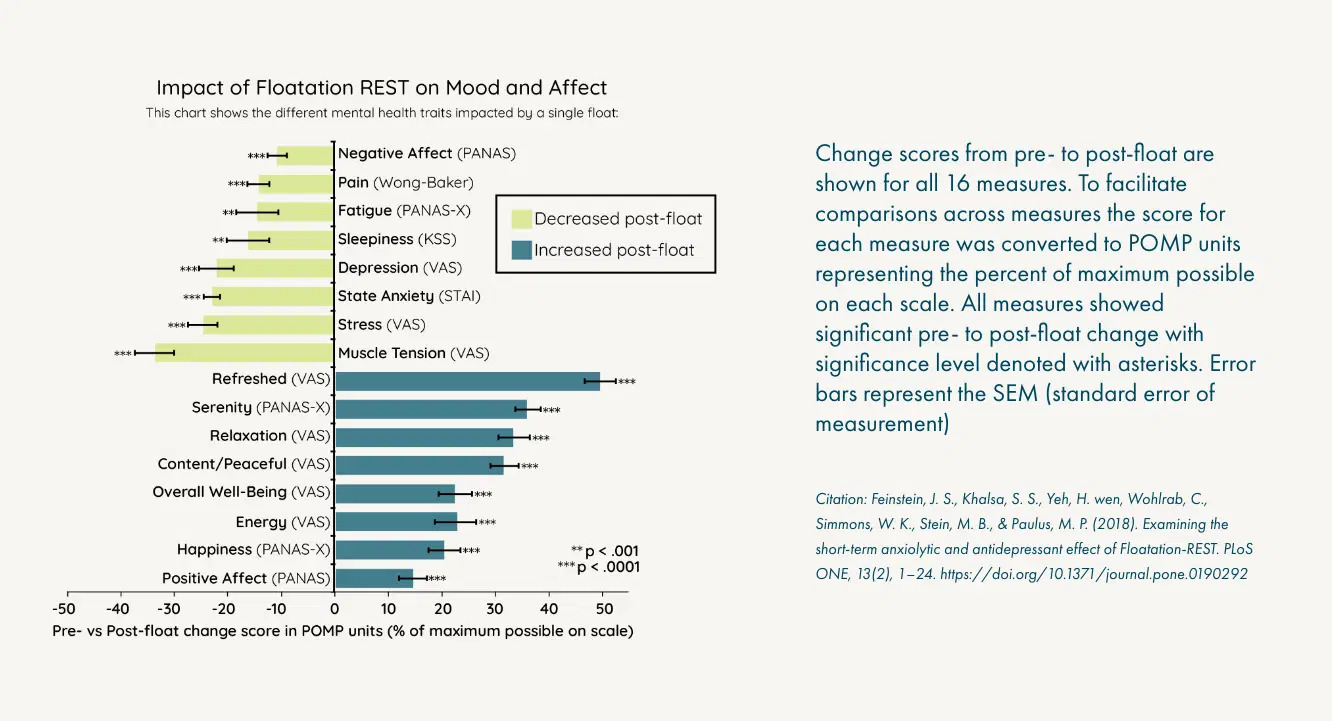A closer look at the science behind sensory deprivation and nervous system regulation
In recent years, interest in non-pharmacological approaches to anxiety relief has grown substantially. From mindfulness-based interventions to somatic therapies, many individuals are seeking strategies that address the root causes of dysregulation rather than simply managing symptoms. One such intervention—float therapy, also known as Flotation REST (Reduced Environmental Stimulation Therapy)—is gaining increased attention for its calming effects on the autonomic nervous system.
But does it work? And more importantly, what does the research say?
A Brief Overview: What Is Float Therapy?
Float therapy involves resting in a dark, soundproof tank filled with skin-temperature water saturated with Epsom salt. The high salt concentration allows the body to float effortlessly, while the absence of external stimuli creates conditions for deep physical and neurological rest.
The experience simulates a state of sensory “zero”—a profound reduction in external input that allows the body and brain to recalibrate.
The Physiology of Deep Rest
At the core of float therapy’s effectiveness is its impact on the autonomic nervous system, particularly the parasympathetic branch responsible for rest, repair, and regulation. During a float session, several physiological markers begin to shift in unison:
- Heart Rate Variability (HRV) increases, indicating enhanced adaptability and stress resilience
- Respiratory Rate slows, deepening into a coherent rhythm
- Blood Pressure tends to stabilize or decrease, reflecting a shift out of sympathetic arousal
This synchronized entrainment—of HRV, respiration, and blood pressure—induces a neurophysiological state of coherence, which has been associated with improved emotional regulation, cognitive flexibility, and overall well-being.
What the Research Says
A growing body of research supports float therapy’s effectiveness for individuals with high trait anxiety. One landmark study published in PLOS ONE (Feinstein et al., 2018) found that even a single session of floatation REST significantly reduced symptoms of anxiety, muscle tension, and stress in participants with clinically diagnosed anxiety disorders. Notably, participants reported immediate improvements in serenity, relaxation, and interoceptive awareness—without adverse side effects.
Another randomized controlled trial (Feinstein et al., 2018) demonstrated that repeated sessions of float therapy resulted in cumulative benefits, including reduced depression and increased resilience. These findings suggest that float therapy may offer both acute and long-term support for individuals seeking anxiety solutions without medication.
Multiple metastudies looking at the effects of floatation therapy across for mental health concerns have reliably demonstrated both strong effect sizes and improved interoceptive capacity among participants.

A Unique Modality in a Crowded Field
While numerous therapies offer anxiety relief, what distinguishes floatation REST is its bottom-up approach. Unlike talk therapy or cognitive reappraisal, float therapy targets the body’s implicit regulatory systems, bypassing the neocortex and working directly with subcortical regions involved in survival, threat detection, and emotional memory.
The float environment provides a rare opportunity to enter non-sleep deep rest (NSDR)—a condition linked to neuroplasticity, memory consolidation, and improved vagal tone. In this deeply restorative state, the body can release long-held patterns of tension, and the nervous system is given the space to reorganize around balance rather than hypervigilance.
Conclusion: A Promising Pathway to Coherence
Float therapy is not a cure-all. But for those experiencing chronic stress or anxiety, it offers a research-backed, non-invasive method for nervous system reset. Its effects are measurable, reproducible, and deeply integrative—addressing both the physiological and psychological dimensions of anxiety.
At Quantum Clinic, float therapy is offered as part of an integrative healing model that includes biofeedback training for heart-brain coherence and frequency-based therapeutic environments. This multimodal approach supports clients in cultivating sustainable emotional regulation and embodied resilience.
Interested in exploring float therapy as part of your mental wellness journey?
Learn more or schedule a session today. A state of coherence may be closer than you think.
References:
Feinstein, J. S., Khalsa, S. S., Yeh, H. wen, Wohlrab, C., Simmons, W. K., Stein, M. B., & Paulus, M. P. (2018). Examining the short-term anxiolytic and antidepressant effect of Floatation-REST. PLoS ONE, 13(2), 1–24. https://doi.org/10.1371/journal.pone.0190292
Feinstein, J. S., Khalsa, S. S., Yeh, H., al Zoubi, O., Arevian, A. C., Wohlrab, C., Pantino, M. K., Cartmell, L. J., Simmons, W. K., Stein, M. B., & Paulus, M. P. (2018). The Elicitation of Relaxation and Interoceptive Awareness Using Floatation Therapy in Individuals With High Anxiety Sensitivity. Biological Psychiatry: Cognitive Neuroscience and Neuroimaging, 3(6), 555–562. https://doi.org/10.1016/j.bpsc.2018.02.005
Tran, K., & Loshak, H. (2021). Floatation Therapy for Mental Health Conditions. Canadian Journal of Health Technologies, 1(12), 1–30. https://doi.org/10.51731/cjht.2021.220
van Dierendonck, D., & Nijenhuis, J. T. E. (2005). Flotation restricted environmental stimulation therapy (REST) as a stress-management tool: A meta-analysis. Psychology and Health, 20(3), 405–412. https://doi.org/10.1080/08870440412331337093

